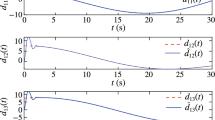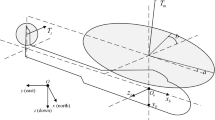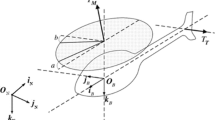Abstract
In this work, by utilizing a disturbance observer-based control (DOBC) method, the resilient tracking control is studied for the unmanned aerial helicopter (UAH) with paramteter uncertainty, multiple disturbances, and input perturbation. Firstly, a state observer and two disturbance observers are respectively constructed to estimate the unmeasurable flapping motion states and outside disturbances, which are further utilized to design the feedforward controller. Secondly, by considering stochastic perturbation, a resilient feedback controller is proposed and an overall closed-loop error system is established. Thirdly, based on stochastic control theory and robust control method, a sufficient condition is obtained to guarantee the asymptotical stability and H∞ performance index for the closed-loop error system. Furthermore, the observer gains and controller one can be jointly checked by solving the derived linear matrix inequality (LMI). Finally, some simulations are presented to verify the effectiveness of the derived control method.
Similar content being viewed by others
References
J. Zhang, X. Y. Cheng, and J. Q. Zhu, “Control of a laboratory 3-DOF helicopter: explicit model predictive approach,” International Journal of Control, Automation, and Systems, vol. 14, no. 2, pp. 389–399, 2016.
H. Q. Wang, A. A. Mian, D. B. Wang, and H. B. Duan, “Robust multi-mode flight control design for an unmanned helicopter based on multi-loop structure,” International Journal of Control, Automation, and Systems, vol. 7, no. 5, pp. 723–730, 2009.
H. C. Kim, H. R. Dharmayanda, T. Kang, A. Budiyono, G. Lee, and W. Adiprawita, “Parameter identification and design of a robust attitude controller using H∞ methodology for the raptor E620 small-scale helicopter,” International Journal of Control, Automation, and Systems, vol. 10, no. 1, pp. 88–101, 2012.
J. Wang, S. Li, J. Fan, and Q. Li, “Nonlinear disturbance observer based sliding mode control for PWM-based DCDC boost converter systems,” Proc. of 27th Chinese Control and Decision Conference, pp. 2479–2484, 2015.
Y. Zhang, Q. Wang, C. Dong, and Y. Jiang, “H∞ output tracking control for flight control systems with timevarying delay,” Chinese Journal of Aeronautics, vol. 26, no. 5, pp. 1251–1258, 2013.
O. F. Lutfy, “Wavelet neural network model reference adaptive control trained by a modified artificial immune algorithm to control nonlinear systems,” Arabian Journal for Science and Engineering, vol. 39, no. 6, pp. 4737–4751, 2014.
I. Ullah and H. Pei, “Fixed time disturbance observer based sliding mode control for a miniature unmanned helicopter hover operations in presence of external disturbances,” IEEE Access, vol. 8, pp. 73173–73181, 2020.
P. Wei, S. N. Chan, S. Lee, and Z. D. Kong, “Mitigating ground effect on mini quadcopters with model reference adaptive control,” International Journal of Intelligent Robotics and Applications, vol. 3, no. 3, pp. 283–297, 2019.
F. Y. Chen, Z. Wang, B. Jiang, and C. Y. Wen, “An improved nonlinear model for a helicopter and its selfrepairing control with multiple faults via quantum information technique,” International Journal of Control, Automation, and Systems, vol. 13, no. 3, pp. 557–566, 2015.
J. Hu, J. Huang, Z. Gao, and H. Gu, “Position tracking control of a helicopter in ground effect using nonlinear disturbance observer-based incremental backstepping approach,” Aerospace Science and Technology, vol. 81, pp. 167–178, 2018.
C. D. Johnson, “Optimal control of the linear regulator with constant disturbances,” IEEE Transactions on Automatic Control, vol. 13, no. 4, pp. 416–421, 1968.
C. D. Johnson, “Further study of the linear regulator with disturbances-the case of vector disturbances satisfying a linear differential equation,” IEEE Transactions on Automatic Control, vol. 15, no. 2, pp. 222–228, 1970.
W. H. Chen, D. J. Ballance, P. J. Gawthrop, and J. O. Reilly, “A nonlinear disturbance observer for robotic manipulators,” IEEE Transactions on Industrial Electronics, vol. 47, no. 4, pp. 2000–2008, 2000.
W. H. Chen, “Disturbance observer based control for nonlinear systems,” IEEE/ASME Transactions on Mechatronics, vol. 9, no. 4, pp. 706–710, 2004.
X. M. Yao, L. Q. Zhu, and L. Guo, “Disturbance-observerbased composite hierarchical anti-disturbance control for singular Markovian jump systems,” IEEE Transactions on Automatic Control, vol. 64, no. 7, pp. 2875–2882, 2019.
H. G. Zhang, J. Han, C. M. Luo, and Y. C. Wang, “Faulttolerant control of a nonlinear system based on generalized fuzzy hyperbolic model and adaptive disturbance observer,” IEEE Transactions on Systems, Man, and Cybernetics: Systems, vol. 47, no. 8, pp. 2289–2300, 2017.
S. B. Qi, H. D. Wang, H. N. Wu, and L. Guo, “Composite antidisturbance control for nonlinear systems via nonlinear disturbance observer and dissipative control,” International Journal of Robust and Nonlinear Control, vol. 29, no. 12, pp. 4056–4068, 2019.
L. Guo and W. H. Chen, “Disturbance attenuation and rejection for systems with nonlinearity via DOBC approach,” International Journal of Robust Nonlinear Control, vol. 15, pp. 109–125, 2005.
H. D. Wang, H. N. Wu, L. Guo, and L. Zhang, “Nonlinear disturbance observer-based control for a class of nonlinear systems,” Proc. of 35th Chinese Control Conference, pp. 2952–2956, 2016.
X. J. Wei, L. W. Dong, H. F. Zhang, X. Hu, and J. Han, “Adaptive disturbance observer-based control for stochastic systems with multiple heterogeneous disturbances,” International Journal of Robust and Nonlinear Control, vol. 29, no. 53, pp. 5533–5549, 2019.
Y. K. Li, M. Chen, T. Li, and H. J. Wang, “Robust resilient control based on multi-approximator for the uncertain turbofan system With unmeasured states and disturbances,” IEEE Transactions on Systems, Man, and Cybernetics: Systems, pp. 1–10, 2020.
W. Jiang, H. Wang, J. Lu, and Z. Xie “HOSVD-based LPV modeling and mixed robust H2=H∞ control design for airbreathing hypersonic vehicle,” Journal of Systems Engineering and Electronics, vol. 27, no. 1, pp. 183–191, 2016.
B. Zhou, S. Xie, and J. Hui, “H-Infinity control for T..S aero-engine wireless networked system with scheduling,” IEEE Access, vol. 7, pp. 115662–115672, 2019.
F. Liu, H. Pei, X. Liu, and H. Cao, “Modeling and H∞ control for small-scale unmanned helicopter,” Proc. of the 29th Chinese Control Conference, pp. 3673–3677, 2010.
X. Fang, F. Liu, and Z. Ding, “Robust control of unmanned helicopters with high-order mismatched disturbances via disturbance-compensation-gain construction approach,” Journal of the Franklin Institute, vol. 355, no. 15, pp. 7158–7177, 2018.
H. Ma, M. Chen, and Q. X. Wu, “Disturbance observerbased inverse optimal tracking control of the unmanned aerial helicopter,” Proc. of IEEE 8th Data Driven Control and Learning Systems Conference, pp. 448–452, 2019.
H. Sun, S. Li, J. Yang, and L. Guo, “Non-linear disturbance observer-based back-stepping control for airbreathing hypersonic vehicles with mismatched disturbances,” IET Control Theory Applications, vol. 8, no. 17, pp. 1852–1865, 2014.
L. Han, X. Wang, S. Li, and J. Liu, “Height and attitude tracking control of an unmanned helicopter via a HDOB-backstepping composite control method,” The Journal of Engineering, vol. 2019, no. 22, pp. 8303–8309, 2019.
J. Zhang, P. Shi, and W. Lin, “Extended sliding mode observer based control for Markovian jump linear systems with disturbances,” Automatica, vol. 70, pp. 140–147, 2016.
Y. K. Li, M. Chen, T. Li, and H. J. Wang “Tracking control for the helicopter with time-varying disturbance and input stochastic perturbation,” ASCE Journal of Aerospace Engineering, vol. 24, no. 3, pp. 961–976, 2020.
J. K. Alireza and A. K. Mojtaba, “Model reference fractional order control using type-2 fuzzy neural networks structure: Implementation on a 2-DOF helicopter,” Neurocomputing, vol. 193, pp. 268–279, 2016.
I. A. Raptis, K. P. Valavanis, and G. J. Vachtsevanos, “Linear tracking control for small-scale unmanned helicopters,” IEEE Transactions on Control Systems Technology, vol. 20, no. 4, pp. 995–1010, 2012.
Author information
Authors and Affiliations
Corresponding author
Additional information
Publisher’s Note Springer Nature remains neutral with regard to jurisdictional claims in published maps and institutional affiliations.
This work is supported by National Natural Science Foundations of China (Nos. 62073164, 61873127, 61922042) and the Foundation of Equipment Pre-research Project of Key Laboratory (No. 61422200306); Qing Lan Project; Fundamental Research Funds for the Central Universities under Grant FRF-BD-20-10A; Research Fund of State Key Laboratory of Mechanics and Control of Mechanical Structures (Nanjing University of Aeronautics and astronautics)(Grant No. MCMS-I-0521G05).
Linbo Chen received his B.E. degree from Civil Aviation Flight University of China in 2019 and currently, he is a master graduate student at the School of Automation Engineering of Nanjing University of Aeronautics and Astronautics, China. His research includes anti-disturbance control with its application to flight control system.
Tao Li received his Ph.D. degree in engineering from Southeast University in 2008 and was a postdoctoral research fellow at the School of Instrument Science and Engineering of Southeast University during 2008 and 2011, China. He has been a visiting scholar at Control System Center of The Manchester University from 2016 to 2017, UK. He is currently an associate professor at the School of Automation Engineering, Nanjing University of Aeronautics and Astronautics in China. His current research interests include neural networks, time-delay systems, networked control systems, etc.
Zehui Mao received her Ph.D. degree in control theory and control engineering from the Nanjing University of Aeronautics and Astronautics, Nanjing, China, in 2009. She was a Visiting Scholar with the University of Virginia from 2015 to 2016. She worked in the areas of fault diagnosis, with particular interests in nonlinear control systems, sampled-data systems, and networked control systems. She is currently a Professor with the College of Automation Engineering, Nanjing University of Aeronautics and Astronautics. Her current research interests include fault diagnosis and fault-tolerant control of systems with disturbance and incipient faults, and high-speed train and spacecraft flight control applications.
Shumin Fei received his Ph.D. degree from Beijing University of Aeronautics and Astronautics in 1995, China. From 1995 to 1997, he carried out his postdoctoral research at Research Institute of Automation of Southeast University, China. Presently, he is a professor and doctoral supervisor at the School of Automation of Southeast University in China. He has published more than 100 journal papers and his current research interests include nonlinear systems, time-delay system, complex systems, and so on.
Rights and permissions
About this article
Cite this article
Chen, L., Li, T., Mao, Z. et al. Resilient Tracking Control for Unmanned Helicopter Under Variable Disturbance and Input Perturbation. Int. J. Control Autom. Syst. 20, 147–159 (2022). https://doi.org/10.1007/s12555-020-0590-7
Received:
Revised:
Accepted:
Published:
Issue Date:
DOI: https://doi.org/10.1007/s12555-020-0590-7




